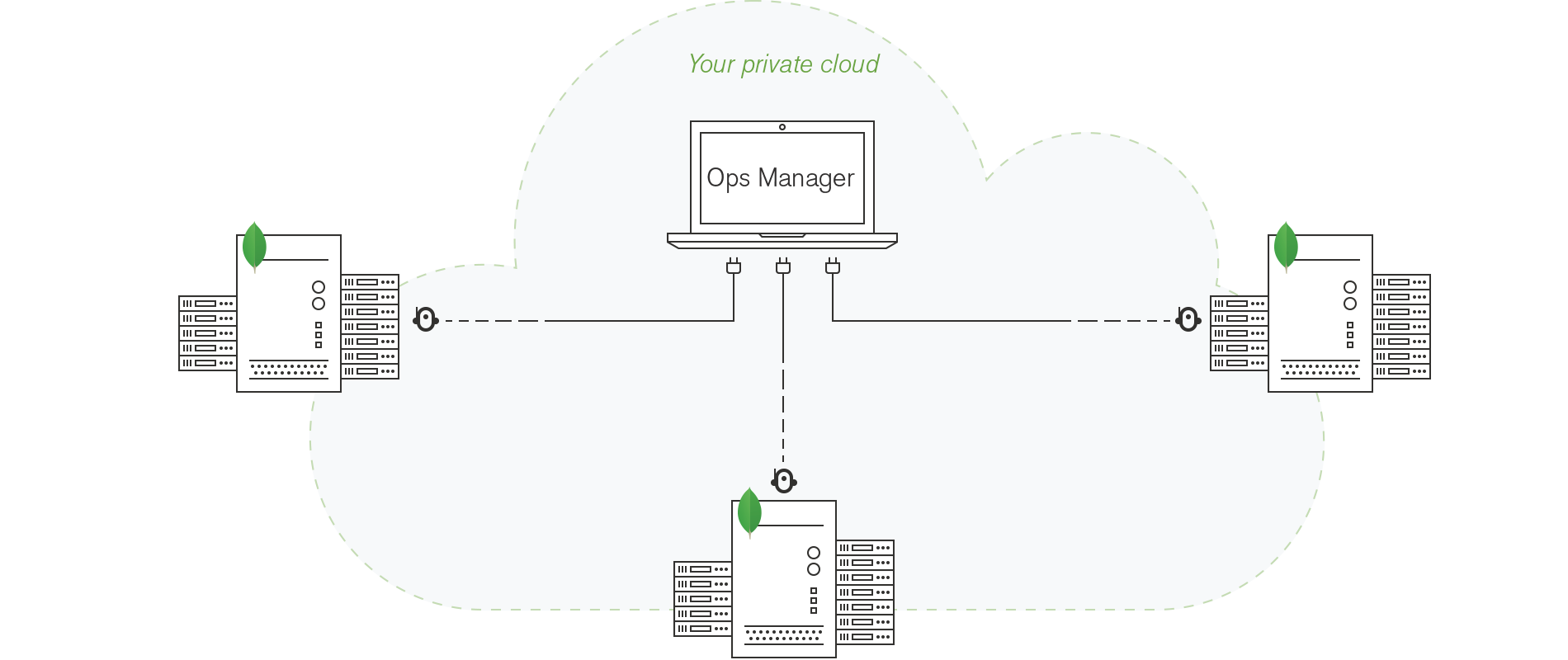Ops Manager Overview¶
On this page
MongoDB Ops Manager can automate, monitor, and back up your MongoDB infrastructure.
Automation¶
Ops Manager Automation enables you to configure and maintain MongoDB nodes and clusters.

How it Works¶
Automation Agents on each MongoDB host maintain your deployments. You can install the Automation Agent so it can provision hosts and deploy clusters in your MongoDB infrastructure.
The Automation Agent also maintains the Monitoring and Backup Agents and starts, restarts, and upgrades the agents as needed.
Automation allows only one Monitoring or Backup Agent per host. It removes additional agents.
Example
When maintaining Backup Agents, Automation removes a Backup Agent from a host that has two Backup Agents.
Monitoring¶
Ops Manager Monitoring provides real-time reporting, visualization, and alerting on key database and hardware indicators.
How it Works¶
A lightweight Monitoring Agent runs within your infrastructure and collects statistics from the nodes in your MongoDB deployment. The agent transmits database statistics back to Ops Manager to report deployment status in real time. You can set alerts on indicators you choose.
Backup¶
The Ops Manager Backup Agent provides scheduled snapshots and point-in-time recovery of your MongoDB replica sets and sharded clusters.
How it Works¶
A lightweight Backup Agent runs within your infrastructure and backs up data from the MongoDB processes you have specified.
Note
Only sharded clusters or replica sets can be backed up. To back up a standalone mongod process, you must first convert it to a single-member replica set.
Backup Data¶
When you start backing up a MongoDB deployment, the agent performs an initial sync of the deployment’s data as if it were creating a new, “invisible” member of a replica set. For a sharded cluster, the agent syncs each shard’s primary member and each config server. The agent sends the initial sync and oplog data over HTTPS back to Ops Manager.
The Backup Agent then tails each replica set’s oplog to maintain on disk a standalone database, called a head database. Ops Manager maintains one head database for each backed-up replica set. The head database is consistent with the original primary up to the last oplog supplied by the agent.
The Backup Agent executes the initial sync and the tailing of the oplog using standard MongoDB queries. The cluster being backed up is unaware of the additional copy of the backup data.
The Backup Agent uses a MongoDB instance version equal to or greater than the version of the replica set it backs up.
The Backup Agent takes and stores snapshots based on a user-defined snapshot retention policy. Sharded cluster snapshots temporarily stop the balancer so that they can insert a marker token into all shards and config servers in the cluster. Ops Manager takes a snapshot when the marker tokens appear in the snapshot data.
The procedures used to reduce the storage space required to store a snapshot depend on where it is stored:
| Snapshot Store | Description |
|---|---|
| MongoDB blockstore | Only the differences of each successive snapshot are stored. Compression and block-level deduplication reduce the size of snapshot data. |
| AWS S3 bucket | Only the differences of each successive snapshot are stored. Compression and block-level deduplication reduce the size of snapshot data. |
| File system store | Depending on the configuration, compression reduces the size of the snapshot data. |
All snapshots represent a full backup.
To learn more about how to configure backups, see Backup Configuration Options.
Restore Data¶
Ops Manager Backup Agents can restore data from a complete scheduled snapshot or from a selected point between snapshots.
- For sharded clusters you can restore from checkpoints between snapshots.
- For replica sets, you can restore from selected points in time.
When you restore from a snapshot, Ops Manager reads directly from the snapshot storage and you can download the snapshot files from an HTTPS link.
When you restore from a checkpoint or point in time, Ops Manager first restores a full snapshot from the snapshot storage and then applies stored oplogs until the specified point is reached. Ops Manager delivers the snapshot and oplog updates using the same HTTPS mechanisms. To enable checkpoints, see Enable Cluster Checkpoints.
You can configure how much of the oplog you want to keep per backup. This affects how much time a checkpoint and point-in-time restore can cover.
Server Pool¶
Server Pools deprecated as of Ops Manager 4.0
As of Ops Manager 4.0, server pools are deprecated and disabled by default.
Ops Manager Server Pool allows Ops Manager users with administrative privileges, i.e. Ops Manager Administrators, to maintain a pool of provisioned servers that already have Automation Agents installed. When users in a project want to create a new MongoDB deployment, they can request servers from this pool to host the MongoDB deployment.
For details, see Provision Servers for the Server Pool.